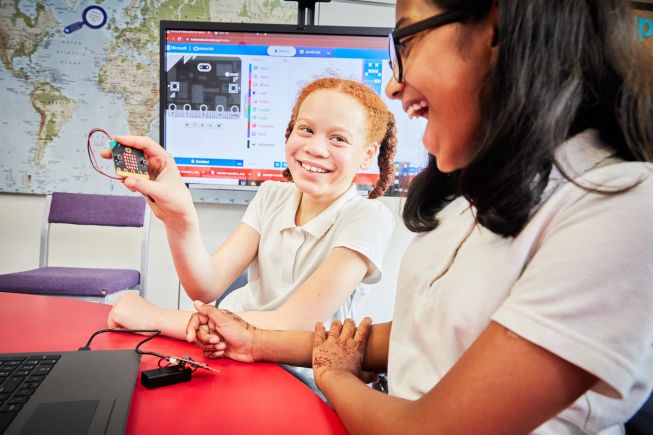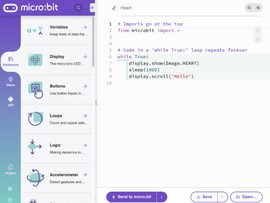Accessibility and the micro:bit - the journey so far
Publishing our accessibility statement is one of many actions we’re taking to make the micro:bit as accessible as possible.

To ‘inspire every child to create their best digital future’, we need to ensure that opportunities to learn digital skills are equally available to all young people. In a project that has been generously funded by Nominet, the Micro:bit Educational Foundation has been working with accessibility consultant, Kirsty McNaught, to identify improvements and opportunities to reduce existing barriers to using the micro:bit. This has included considering changes or additions to our products, or by supporting teachers to understand what is possible by adapting resources. We have worked together with Kirsty to develop accessibility statements, and here we outline where we’ve got to so far.
Why focus on accessibility?

By embracing inclusive teaching we are investing in a future where today’s students, including those with disabilities, become tomorrow’s teachers, leaders and technologists.

Kirsty McNaught, accessibility consultant
In her report for this work, Kirsty highlights that it’s crucial we ensure that the term “every child” includes those with disabilities and learning differences. Many of these individuals rely on technology to level the playing field, making it all the more important that it is inclusive. Furthermore, technology will be better, more effective and inclusive in the future if those who rely on it are also creators of it. Computer science education, therefore, has a particular responsibility to be inclusive. It has the power to enable students with disabilities and learning differences to understand technology, take ownership of their tools and become creators in their own right.
Kirsty goes on to identify that the micro:bit is already a powerful tool in reducing exclusion both in the computing syllabus and in the wider curriculum. Its low-cost hardware makes it accessible to more people globally, and the small form factor makes it easy to integrate into projects that are of interest to a diverse range of students, from robotics to wearable circuits. The micro:bit’s tactile nature allows for a more physical and interactive mode of learning, which can be particularly beneficial for neurodiverse students or those with different styles of learning who might not always suit traditional modes of teaching. The impact of this can extend beyond computer science lessons when the micro:bit is used across the wider curriculum.
What is an accessibility statement for?

We felt it was important to have a space to share our intentions, roadmap and importantly a way for teachers and learners to let us know specific use cases so that we can build that into future plans where possible.

Emma Mumford, Director of Operations, Micro:bit Educational Foundation
Teachers often design classes to support students with a wide range of access needs, perhaps access needs that they themselves don’t have. The Foundation works with students and teachers globally, so we wanted to provide information in our accessibility statements to support the inclusion of these students, identifying features that may be helpful. We want our users to feel confident using our resources and tools, and know what is and is not possible.
Lucy Gill, Head of Product at Micro:bit Educational Foundation, recalls a conversation she had at micro:bit Live Barcelona: “Juanjo Montiel, a blind developer, told me that he has such low expectations of coding software, that when someone had suggested he try the micro:bit Python Editor, he had been reluctant and didn’t expect to be able to use it. However, he’d been very pleasantly surprised, discovering it worked well with his screen reader and was easy for him to understand. He was overflowing with praise for it and said his only criticism was that we hadn’t told everyone how accessible it is!”
Our accessibility statements (including the micro:bit Python Editor accessibility statement) help address this need to inform our users. By being transparent, we also want to ensure that accessibility remains a focus for our team, helping to identify what we have and have not yet done, so we can prioritise our roadmap of future improvements.
What does accessibility mean for micro:bit?
Accessibility has always been an important consideration for micro:bit. We comply with guidelines like the Web Content Accessibility Guidelines (WCAG) but for us, there is more to it than compliance. A holistic approach is needed, that considers how inclusive the whole learning experience is, and ensures a sense of belonging for every child. Considering adaptations and suggestions we can provide in our learning materials is as important as the accessibility of the products themselves.
Working with Kirsty has helped us to establish a firmer basis of understanding and momentum to do more. The project has also helped us take time to gather feedback from users with accessibility needs, formally and informally. These important steps will continue to be built into our processes.
The journey so far
As a small non-profit with limited resources, we have had to prioritise which parts of the journey to tackle first. This work has helped us recognise that, whilst there is always more to do, it is important to let our community know what we have and have not done so far.
- Digital products: Reviewing our main digital products has led us to create accessibility statements, and a roadmap for improvements. We focused on areas actively being developed so changes could be easily incorporated, as well as areas that would have most impact, such as our most popular pages, those relating to getting started with the micro:bit and our support site. There are still areas of our digital products that we are yet to review, but this is planned for the future.
- The micro:bit device: We have reviewed the accessibility of the micro:bit device and investigated how existing accessories can help overcome accessibility barriers. We are in the process of turning this feedback into guidelines, which we plan to publish later in 2024. This work has also highlighted accessibility issues that could be significantly reduced with new hardware. We are considering the best approach to enabling or obtaining funding to pursue this further.
- Internal processes: This accessibility project has helped us to improve internal processes to ensure accessibility is considered at every stage. We have started to establish approaches to gather insights, feedback, case studies and testing approaches for accessibility, and develop relationships in the accessibility community.
Where next?

At micro:bit, we are committed to our vision to inspire every child’s best digital future. Our work to be inclusive and accessible is ongoing and we will continue to make the changes we believe will have significant impact.

Lucy Gill, Head of Product, Micro:bit Educational Foundation
We know that this is a continuous journey and we still have a long way to go. New challenges are also emerging on the digital side as we expand the learning opportunities for micro:bit to include data science and artificial intelligence, not just coding. How best to convey data in graphs via a screen reader and how to make machine learning lessons inclusive are just two of the recent topics. Huge thanks to Nominet for making this project possible.
If you have experiences to share, suggestions, feedback, the opportunity and willingness to try things out with SEND users as they are developed or can offer expertise or funding to help us progress, we would love to hear from you.
Get in touch about accessibility by emailing accessibility@microbit.org

